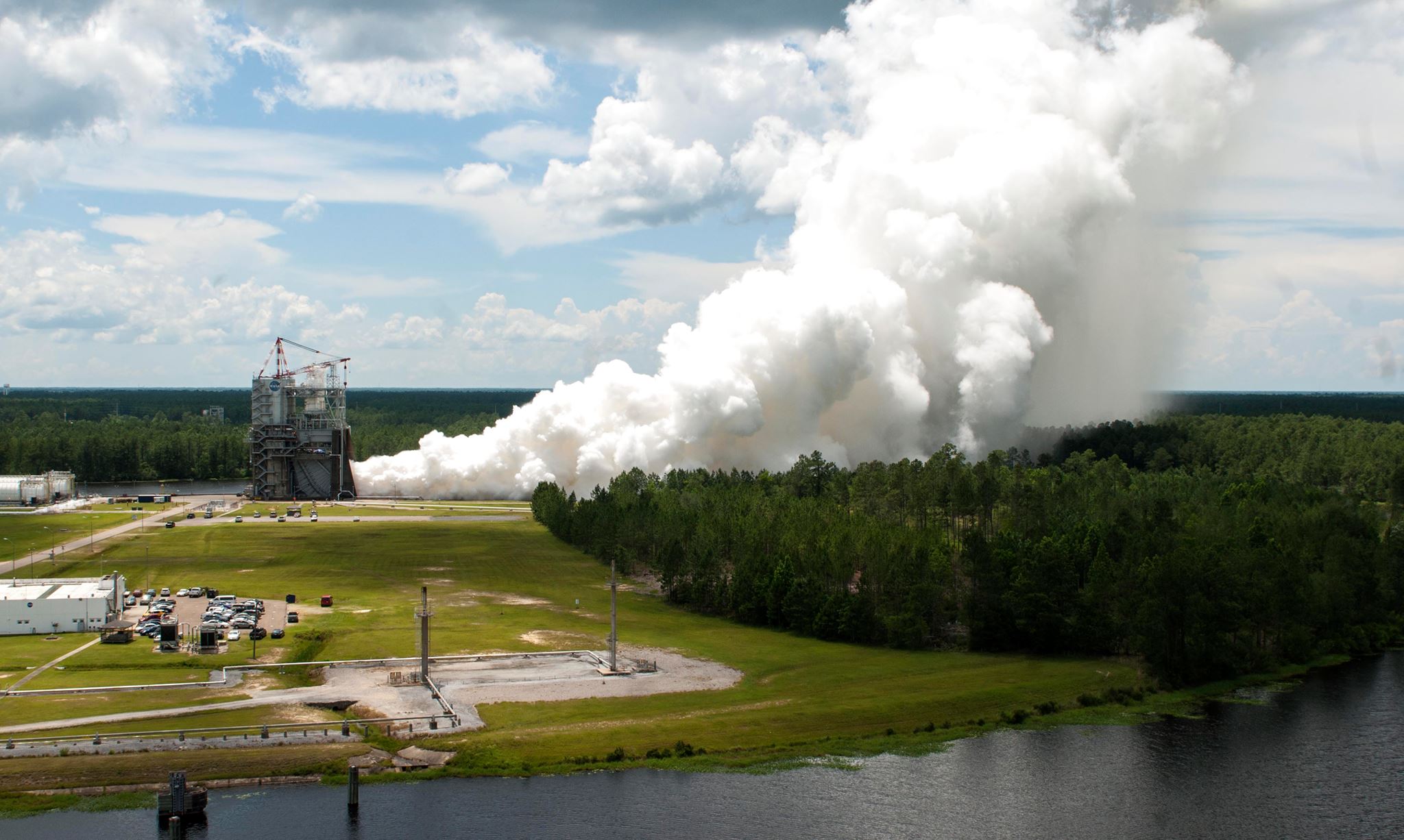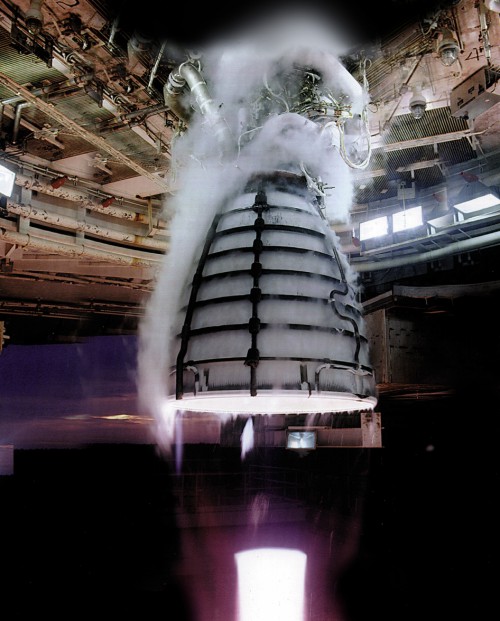
NASA and Aerojet Rocketdyne fired up their RS-25 development engine for the second time in as many weeks today, sending a thunderous roar across Stennis Space Center as the engine successfully carried out its third test fire for NASA’s Space Launch System (SLS); the colossal 320-foot tall rocket which will launch astronauts to destinations farther from home than any human in history has ever been to serve NASA’s deep space ambitions over the coming decades.
“While we are using proven space shuttle hardware with these engines, SLS will have different performance requirements,” said Steve Wofford, manager of the SLS Liquid Engines Office at NASA’s Marshall Space Flight Center in Huntsville, Alabama. The Marshall Center manages the SLS Program for the agency. “That’s why we are testing them again. This is a whole new ballgame — we need way more power for these engines to be able to go farther than ever before when it comes to human exploration. And we believe the modifications we’ve made to these engines can do just that.”

The 500-second test fire, carried out by development engine #0525 on the historic A-1 test stand, went off without issue—something that has come to be expected of the RS-25 engine, which formerly powered NASA’s now-retired space shuttle fleet uphill on 135 missions. The RS-25 was the first reusable rocket engine in history, as well as being one of the most tested large rocket engines ever made, having conducted more than 3,000 starts and over one million seconds (nearly 280 hours) of total ground test and flight firing time over the course of NASA’s 30-year space shuttle program.
The engines proved their worth time and time again, but the RS-25 now requires several modifications to meet the giant rocket’s enormous thrust requirements.
Today’s test fire will provide engineers with critical data on the engine’s new state-of-the-art controller unit—the “brain” of the engine, which allows communication between the vehicle and the engine itself, relaying commands to the engine and transmitting data back to the vehicle. The new controller also provides closed-loop management of the engine by regulating the thrust and fuel mixture ratio while monitoring the engine’s health and status, thanks to updated hardware and software configured to operate with the new SLS avionics architecture.
“We’ve made modifications to the RS-25 to meet SLS specifications and will analyze and test a variety of conditions during the hot fire series,” said Wofford after the first test fire earlier this year. “The engines for SLS will encounter colder liquid oxygen temperatures than shuttle; greater inlet pressure due to the taller core stage liquid oxygen tank and higher vehicle acceleration; and more nozzle heating due to the four-engine configuration and their position in-plane with the SLS booster exhaust nozzles.”
For shuttle flights the engines pushed 491,000 pounds vacuum thrust during launch—each—and shuttle required three to fly, but for SLS the power level was increased to 512,000 pounds vacuum thrust per engine, and the SLS will require four to help launch the massive rocket and its payloads with a 70-metric-ton (77-ton) lift capacity that the initial SLS configuration promises.
The pace for SLS engine testing at Stennis is expected to pick up this summer. After the first test fire on Jan. 9, upgrades were needed on the A-1 test stand’s high pressure industrial water system, which provides cool water for the test stand during a hot-fire engine run. Engine 0525 will carry out a total of seven test fires in this first series of tests and will fire for a grand total of 3,500 seconds, followed by another 10 test fires with another development engine, which will be put through its paces for a grand total of 4,500 seconds.
To put the power of the Aerojet Rocketdyne-built RS-25 engines into perspective, consider this:
- The fuel turbine on the RS-25’s high-pressure fuel turbopump is so powerful that if it were spinning an electrical generator instead of a pump, it could power 11 locomotives; 1,315 Toyota Prius cars; 1,231,519 iPads; lighting for 430 Major League baseball stadiums; or 9,844 miles of residential street lights—all the street lights in Chicago, Los Angeles, or New York City.
- Pressure within the RS-25 is equivalent to the pressure a submarine experiences three miles beneath the ocean.
- The four RS-25 engines on the SLS launch vehicle gobble propellant at the rate of 1,500 gallons per second. That’s enough to drain an average family-sized swimming pool in 60 seconds.
WATCH: SLS Main Engine Test Fire #3, Stennis Space Center June 11, 2015
Four previously-flown RS-25 engines will be attached to the first SLS core stage, which will be manufactured at Michoud Assembly Facility in New Orleans, and test fired together atop the B-2 test stand at Stennis as a stage before being approved for the first SLS launch, planned for late 2018.
NASA currently has 16 RS-25 engines in their SLS inventory, 14 of which are veterans of numerous space shuttle missions. Aerojet Rocketdyne just recently finished assembly of the sixteenth engine, engine 2063, one of the space agency’s two “rookie” RS-25’s. It will be one of four RS-25 engines that will be employed to power the SLS Exploration Mission-2 (EM-2), the second SLS launch currently targeted for the year 2021.
“There is nothing in the world that compares to this engine,” said Jim Paulsen, vice president of Program Execution Advanced Space & Launch Programs Aerojet Rocketdyne. “It is great that we are able to adapt this advanced engine for what will be the world’s most powerful rocket to usher in a new space age.”
The SLS program also kicked off its Critical Design Review (CDR) last month at NASA’s Marshall Space Flight Center in Huntsville, Ala., which demonstrates that the SLS design meets all system requirements with acceptable risk and accomplishes that within cost and schedule constraints. The CDR proves that the rocket should continue with full-scale production, assembly, integration, and testing, and that the program is ready to begin the next major review covering design certification. The SLS CDR is expected to be completed by late July.
Be sure to “Like” AmericaSpace on Facebook and follow us on Twitter: @AmericaSpace
Missions » SLS »




One Comment
One Ping
Pingback:NASA to Test Orion’s European Service Module Starting This Summer « AmericaSpace